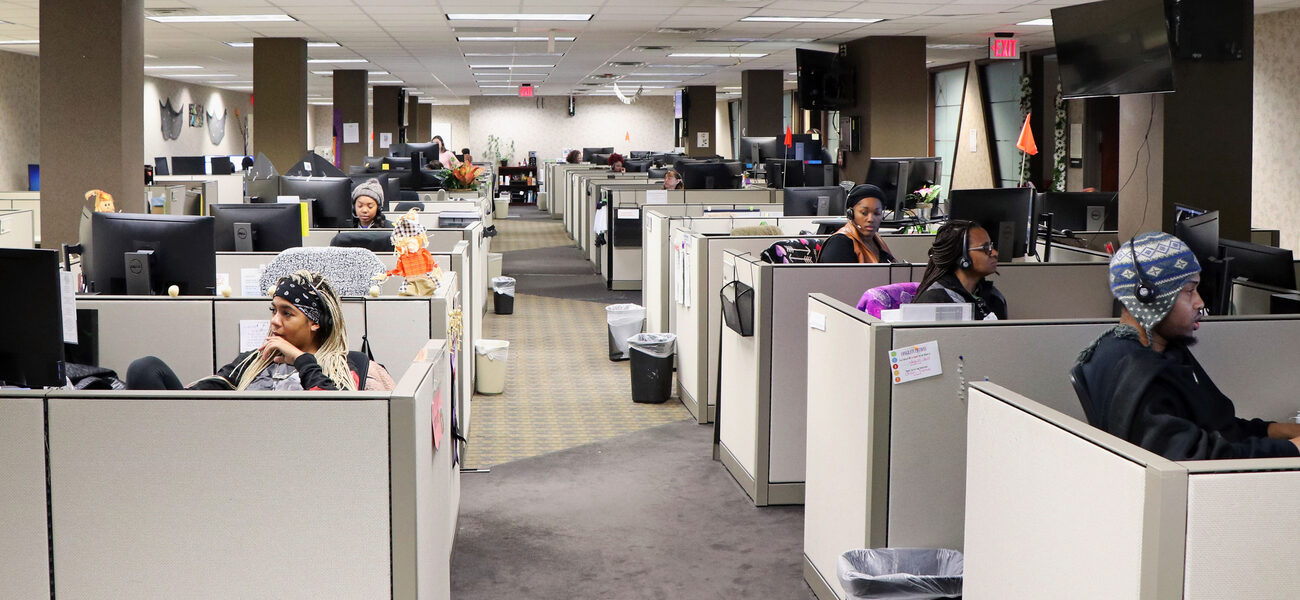Implementation of a remote workforce and a restructuring of their onsite physical space have helped to improve employee retention rates while also increasing overall productivity and quality at Vanderbilt University Medical Center (VUMC) in Nashville, Tenn. Calls from patients looking to schedule appointments are initially answered by one of the 260 phone agents who comprise the Patient Access Services department. Answering more than 10,000 calls on average every day and handling a total of 4.2 million inbound and outbound calls annually, these phone agents have a fast-paced, demanding position that experiences approximately 25 percent turnover each year. This turnover rate is low compared to the 32 percent national average for call centers, says Elizabeth Nix, director of service quality and development for the department.
“Every day, each agent handles between 60 to 100 calls, and that figure has been steadily increasing by about 5 percent annually,” says Nix. Last year alone, the agents processed 2.6 million inbound calls and 1.6 million outbound calls, and scheduled more than 3 million patient appointments.
Implementing remote workforce processes served the medical center well when the coronavirus forced employees across the country to work from home, many for the first time in their career.
“The foundation we had in place enabled us to send our entire workforce of about 150 agents and 45 support staff home in less than a week, and to remain productive throughout this event,” says Nix. “We have also changed our approach to performance issues and are managing those remotely to limit in-person contact. When people need to be onsite in our offices for training or technical support, we have adjusted our processes to include social distancing and our organizational policies around masking and temperature monitoring.”
Adding a Remote Workforce
VUMC started its Remote Access Program (RAP), which allows call center agents to work from home, in mid-2016, but Nix feels that it did not gain momentum until 2018, when it was taken over by Tara Hubbard, program manager, who completely reorganized it, created branded resources, and standardized accountability. Her efforts drove participation from an average of 30 agents, to over 100. In comparison to their counterparts in the hospital setting, RAP agents routinely score 4 percent higher on customer service/quality monitoring and take 10-15 more calls per day,
“By offering the option to work from home, we are giving people of different personality types and different preferences the option to be productive in the way that they are most comfortable with,” says Nix. “We have some people who would never in a million years want to work from home, because they are too social and want to be in the office. But we also have people who don’t want to get caught up in any kind of office friendships or drama and prefer to work remotely.”
Nix adds that the remote option has also been very popular with workers who live farther from the hospital, since spending less on gas and transportation effectively increases their income. Currently, 75 miles is the farthest that remote workers can live from the medical center, because they are required to bring their equipment in to resolve any technical difficulties the same day issues are discovered. RAP agents are also required to attend training and regular department meetings, which vary based on their team’s specialty. Those meetings had been conducted on site before the pandemic, but are also being handled remotely now.
“We have found that workers who choose to work remotely often prefer the emotional comfort they find from working in their own personal space,” says Nix. “It goes beyond just the convenience of getting to work in their pajamas all day!”
According to Nix, the following are keys to keep in mind when developing a remote worker program.
Set clear rules by providing specific guidelines for remote workers. At VUMC, each remote worker is asked to sign a 10-page alternative work arrangement policy that spells out the equipment requirements as well as performance expectations. In addition to their laptop, each remote worker is given a headset, keyboard, and two monitors, and is required to have high-speed internet access compatible with the hospital’s phone software and electronic medical records system.
Monitor consistently by staying in touch with remote workers daily and by analyzing performance metrics monthly. “Unlike that famous infomercial for Ronco rotisserie chicken, you can’t ‘set it and forget it’ when it comes to remote agent engagement. You need someone to be monitoring it every day and holding workers accountable,” says Nix. She adds that VUMC plans to switch their current phone system setup for one that will allow callers to participate in post-phone-call surveys to provide additional performance review data.
Stay connected by keeping lines of communication open with remote workers, not just by email. Some examples Nix cites are delivering pizza to remote workers on days when it’s also being served in the office, mailing birthday cards, or calling just to catch up in person every so often.
Other tools that VUMC uses daily to stay connected to their remote workforce include video chats, screen sharing thru Skype for Business, and videoconferencing through Zoom. Each quarter, the remote agents also receive a care package that includes tip sheets and newsletters, as well as handwritten cards from their team leaders. “Any time we form a work group in our office to tackle a problem, we make sure that it includes one or two people from our remote program, so that they can give the perspective of what it means for workers at home,” says Nix.
She also points to the department’s 2019 acquisition of stand-up desks for onsite workers as an example of a positive outcome from communication. Stand-up desks were a consistent request from employees on engagement surveys and other feedback forms, so the desks were purchased for all on-site agents as a reward for meeting annual goals the previous fiscal year. Remote workers are given a full computer and phone set-up from Vanderbilt but are responsible for providing their own furniture within their home office space.
Brand your program by creating a specific name and/or logo to set the remote program apart and emphasize specific responsibilities and benefits associated with working remotely. “When VUMC incorporated the RAP branding for our program, it was an important step in telling our employees we were serious about making this program work,” says Nix.
Designate space for remote workers to easily come into the office and work when necessary. At VUMC, the 15,750-sf call center includes only 245 cubicles, so remote workers no longer have their own personal desk on site. Instead VUMC has designated 17 cubicles as touch-down stations that are available for remote workers to use by bringing in their personal laptops and headsets.
Renovating the Call Center’s Physical Space
Eliminating the empty desks previously reserved for remote workers saved VUMC approximately 2,500 to 3,000 sf of space and improved morale, since the empty desks inevitably turned into junk-collecting eyesores. The department was able to save another 1,000 sf by consolidating space between teams. With this new-found space, VUMC gained space for their new referral management department and a computer lab for new hires.
“In addition to better utilizing our square footage, we restructured our seating arrangements and the way teams are organized to more accurately reflect our organizational goals,” says Nix. “We were asking our people to interact more and cross-train with other teams, but our physical space was not conducive to this.”
VUMC’s Patient Access department is organized into 12 distinct teams covering 27 clinical services, which include primary care, along with all of the medical specialties offered at the hospital, such as cardiology, gastroenterology, and radiology services. Nix describes the placement of staff within the two floors occupied by the department as “random” prior to the space reorganization.
“After our reorganization, we were able to bring together all of our specialty clinic staff on one floor,” says Nix. “The call center feels very vibrant, with a lot of cross-conversation between teams, and a lot of sharing of processes and information across specialties.”
VUMC also moved the teams closer together and lowered the height of all cubicle walls from 66 to 42 inches to make it easier to seek help from other agents.
“At first, there were concerns about the lack of privacy with lower walls, but within two days, those grumbles went away, when everyone realized they no longer needed to use Skype for Business to know if the person next to you is available,” says Nix. “In a call center, it’s a huge benefit to be able to see who you can reach out to for help.”
She added that they took this idea one step further and had a little fun with it by giving everyone in the call center gold pom-poms for their desk to wave as a signal when they need immediate help.
Positive Space Encourages Retention
“Your space can hurt or help your engagement, and ultimately that is going to drive your organizational performance,” says Nix. “Engaged employees are more productive, and that will impact your profitability, your revenue, and your future growth.”
Nix feels that creating an effective space that engages both remote and onsite workers is a powerful tool to:
- Increase retention, since studies show that an engaged employee is 60 percent less likely to leave your organization in the next year.
- Improve collaboration and innovation by encouraging employees to participate in teams. As employees form bonds with their coworkers, they tend to feel more engaged, and this teamwork typically inspires more innovative ideas and solutions.
- Maintain positive attitudes and behaviors, by building a sense of community and pride in the quality of service.
It is unclear what VUMC’s space plan will look like when the risk of the coronavirus has passed.
“We are rethinking our physical space from the perspective of how much we actually need if we remain mostly remote,” says Nix. “We surveyed our staff in May, and over 80 percent of the agents who were working in the office before the pandemic said they would like to remain at home. Our professional support staff have also expressed a desire to stay home, helping us to further support this strategy.
“We have also found a lot of engagement potential through Microsoft® Teams, in addition to our use of Skype and Zoom. It has become our preferred method for hosting meetings and collaborating. It has also enabled remote training and precepting in a unique way, and we have gotten some good feedback about how easy it is to use.
“Engaged employees provide a better customer experience, whether that means answering a call from a patient scheduling an appointment, a physician calling another physician, or a family member just calling to check on a loved one,” says Nix. “We consider everyone who calls us our customer, and quite frankly, engaged employees just provide better care to all of our customers.”
By Amy Cammell

